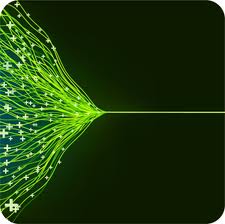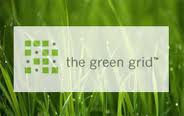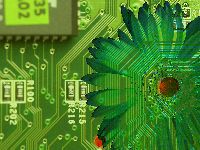
Green IT
EKT and Green IT
Now:• 7 virtual servers running
• By 1,27 KW lower power consumption
• Power Usage Effectiveness (PUE): 2,11
Estimated since 2008:
• 1.247,51 fewer tones of CO2 emissions released into the atmosphere
• By 1.247.511,14 KWh lower energy consumption
Research Infrastructure at the National Documentation Centre of Greece (EKT) effectively implements Green IT technologies according to the international standards and regulations with an aim to minimising the environmental effects of computing.
- What is Green IT?
- Why Green IT is so important
- The International Landscape
- How the National Documentation Centre of Greece (EKT) applies Green IT
- Green IT and the National Information System for Research and Technology (NISRT)
- Future Plans

What is Green IT?
The goal of Green IT (or Green Computing) is to increase environmental sustainability reducing energy use and pollution footprint throughout the entire ICT lifecycle, from initial manufacture, through delivery, use, maintenance, recycling and disposal in an economically realistic way. Green IT or Green Computing refers to “the study and practice of designing, manufacturing, using, and disposing of computers servers, and associated subsystems efficiently and effectively with minimal or no impact on the environment" (San Murugesan, 2008). Adopting and implementing Green ICT principles and practices can help industries become more energy-efficient and contribute to reducing the country's energy dependence.
The term Green IT includes a number of activities and focus areas such as design for environmental sustainability, energy-efficient computing, use of renewable energy sources, eco-labeling, regulatory compliance, green metrics, assessment tools, disposal and recycling, server virtualization, green data center design, green manufacturing etc. The Green approach to computing addresses a broad range of environmental issues by demanding a set of optimal management activities, cost benefit –related processes and technologies such as virtualization, Recycling and Telecommuting.

Why Green IT is so important
Recognizing that Information and Communications Technology (ICTs) has become a significant source of energy consumption, ICT can contribute to the global efforts for minimizing energy consumption and reversing the effects of climate change. Since information technologies are part of the environmental problem, they can also be part of the solution and play a critical role in reducing energy waste and increasing energy efficiency throughout the economy.
ICT equipment today makes up about 5.3 percent of global electricity use. The International Energy Agency predicts that the energy consumed by ICT worldwide will double by 2022 and increase three fold by 2030 to 1,700 tera (trillion) watt hours, presenting a great challenge to electric utilities throughout the world.
The average PC consumes 588 kilowatt-hours of electricity per year, and wastes almost 400 kWh of that by running at full-power when not in use. Putting a computer in sleep mode during inactive times can achieve at least a 20 percent reduction in electricity consumption and result in average savings of $50 per year for each PC.
However, cutting costs and improving environmental performance are not mutually exclusive issues. Studies show that a combination of improved operations, state-of-the-art technologies and best practices can bring important energy and electricity cost savings. As energy demands grow, getting control over energy use will become an important advantage for governments, organizations and businesses. A growing number of companies, governments and organizations around the world have faced these challenges as strategic opportunities and adopt forward-looking, green-friendly policies and practices to reduce the environmental impacts of their IT operations. Better energy efficiency for IT operations, power management without sacrificing performance, increased productivity and efficiency, cut in costs and higher ROI (Return on Investment), ease of deployment of systems are only some of the benefits that Green IT initiatives have to offer.

The International Landscape
 Recognizing that Green IT becomes increasingly important, international community has developed structures and organizations which promote the implementation of Green principles. The Green Grid is a large non-profit, open industry consortium of end-users, technology providers, policy-makers, facility architects, and utility companies collaborating to improve resource efficiency in information technology and data centers. With more than 175 member companies around the world, The Green Grid seeks to unite global industry efforts, create a common set of metrics, and develop technical resources and educational tools to further its goals
Recognizing that Green IT becomes increasingly important, international community has developed structures and organizations which promote the implementation of Green principles. The Green Grid is a large non-profit, open industry consortium of end-users, technology providers, policy-makers, facility architects, and utility companies collaborating to improve resource efficiency in information technology and data centers. With more than 175 member companies around the world, The Green Grid seeks to unite global industry efforts, create a common set of metrics, and develop technical resources and educational tools to further its goals
At the political level, the European Commission supports Green initiatives. The Code of Conduct on Data Centers’ Energy Efficiency describes best practices leading to the minimization of energy consumption for datacenters in Western Europe and includes a series of voluntary measures laying out a set of minimum standards of compliance with the principles of Green IT.
In view of a need for better and more efficient use of public funds in the context of the global economic downturn, at the European level, there is an increasing pressure on publicly funded e-Infrastructures to adopt more sustainable approaches to ICT use. In the context of Europe’s ‘Green Agenda’, there are myriad of initiatives, interventions and projects taking place at both national and institutional level. In this area, the challenge remains to manage energy consumption at the service level, optimize resources and cause a net reduction in energy use. In this direction, the EU has committed to reduce emissions by 20% (on 1990 levels) by 2020 and to increase the target to 30% if there are similar commitments from other developed countries.
The Digital Agenda for Europe 2020 recognizes the significant role of Green IT in the global effort for cutting down global levels of energy consumption and invites the IT sector to build a common digital market based on interoperability standards and a common political and regulatory framework which pursues Europe’s 2020 targets for energy and climate change.
How EKT applies Green IT
The National Documentation Center of Greece (EKT) hosts an advanced Datacenter which applies the main features of Green computing and follows the best practices in the field as defined at an international level:
- Regulations, measurements and monitoring processes introduced by the Green Grid.
- Cloud technologies, virtualization techniques and European targets on improving energy effectiveness (according to EU Europe 2020 Digital Agenda Strategy).
- Actions which comply with EU code of Conduct for Data Center and aim at improving the energy efficiency of the Datacenter.
 Since 2007, the National Documentation Center (EKT) applies measurement technologies to monitor and take actions for improving energy efficiency and reduce the environmental effects of its datacenters and digital infrastructure. EKT applies virtualization technologies and has succeeded in significantly reducing data center power with server consolidation and relevant measured reduction of energy consumption.
Since 2007, the National Documentation Center (EKT) applies measurement technologies to monitor and take actions for improving energy efficiency and reduce the environmental effects of its datacenters and digital infrastructure. EKT applies virtualization technologies and has succeeded in significantly reducing data center power with server consolidation and relevant measured reduction of energy consumption.
Also, according to a series of studies (ELLAK 2008, 2009), we developed a set of software tools for measuring, recording and reporting the amounts of energy which has been saved. At EKT's Datacenter –which also hosts the servers: HellasGrid Athena and GRIX/GEANT- we installed systems for monitoring and measuring the power consumption. The above actions were implemented in the frame of the project 'National Information System for Research and Technology'.
According to these technological interventions, it is estimated that since 2008, we have consumed at least 387.940 fewer Kwh (resulting in 387 fewer tones of CO2 in the environment.).
Green IT and NISRT
The principles of Green IT have been a focal point for the implementation of the National Information System for Research and Technology (NISRT), a national research infrastructure that EKT develops in the frame of its official role. Specifically, the following tasks were completed:
- EKT Datacenter renovation: At EKT's Datacenter, we installed the system "Cold Isle Containment", which provides special energy efficiency since it effectively traps the cool air exactly where it is needed. Also we used Computational Fluid Dynamics, (CFD) – a branch of fluid mechanics that uses numerical methods and algorithms to solve and analyze problems-. Those actions have significantly reduced the Datacenter's Power Usage Effectiveness (PUE). It is estimated that for each 5% improvement at the Datacenter's energy efficiency, there are 50 tones less emissions of CO2 in the environment.
- The development and installation of software for measuring and monitoring a set of environmental metrics in real time (Power Usage Effectiveness).
- The integration of environmental metrics into its overall IT dashboard. Metrics are constantly reported and published (daily measures in real time) through various dissemination modes (e.g. twitter, project website, wikis)
- Expansion of the system's affordances. The system's new version provides graphic representations of the energy and power rates measured. Top of the page
Future Plans
 The Center currently undertakes activities in the field of Cloud Computing according to the Software as a service (SaaS) delivery model. Digital services are designed to address the Greek Community of Libraries, Archives, Museum and the country's cultural, research and educational institutions.
The Center currently undertakes activities in the field of Cloud Computing according to the Software as a service (SaaS) delivery model. Digital services are designed to address the Greek Community of Libraries, Archives, Museum and the country's cultural, research and educational institutions.
The implementation of Green IT in the field of SaaS applications are of major significance for the environment, the economic viability and the effectiveness of the services. EKT will continue to provide advanced digital services and develop software solutions which adopt the principles of Green IT and run according to international Green standards, in a way that drive measurable financial and environmental benefits.










